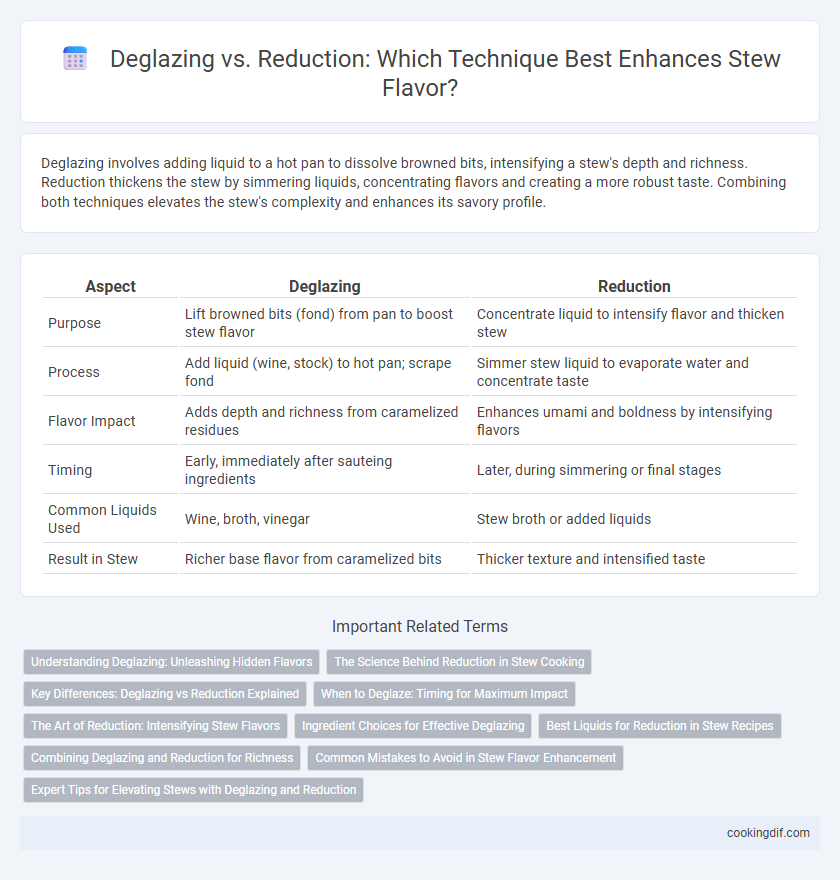Deglazing involves adding liquid to a hot pan to dissolve browned bits, intensifying a stew's depth and richness. Reduction thickens the stew by simmering liquids, concentrating flavors and creating a more robust taste. Combining both techniques elevates the stew's complexity and enhances its savory profile.
Table of Comparison
| Aspect | Deglazing | Reduction |
|---|---|---|
| Purpose | Lift browned bits (fond) from pan to boost stew flavor | Concentrate liquid to intensify flavor and thicken stew |
| Process | Add liquid (wine, stock) to hot pan; scrape fond | Simmer stew liquid to evaporate water and concentrate taste |
| Flavor Impact | Adds depth and richness from caramelized residues | Enhances umami and boldness by intensifying flavors |
| Timing | Early, immediately after sauteing ingredients | Later, during simmering or final stages |
| Common Liquids Used | Wine, broth, vinegar | Stew broth or added liquids |
| Result in Stew | Richer base flavor from caramelized bits | Thicker texture and intensified taste |
Understanding Deglazing: Unleashing Hidden Flavors
Deglazing unlocks rich, nuanced flavors by dissolving browned food residues from the pan with liquid, often wine, broth, or stock. This technique captures the caramelized bits, known as fond, infusing the stew with deep umami and complexity. Proper deglazing ensures a balanced base that elevates the overall taste profile of hearty stews.
The Science Behind Reduction in Stew Cooking
Reduction in stew cooking intensifies flavor by evaporating water content, concentrating the stew's natural sugars, amino acids, and acids through heat. This process promotes Maillard reactions and caramelization, enriching the stew with complex, savory, and slightly sweet notes. The controlled simmering facilitates nutrient extraction from ingredients, resulting in a deeply flavorful and aromatic broth.
Key Differences: Deglazing vs Reduction Explained
Deglazing involves adding liquid to a hot pan to dissolve browned food particles, creating a flavorful base for sauces, while reduction concentrates flavors by simmering or boiling liquid until it thickens. Deglazing is a quick process that captures caramelized bits for immediate sauce creation, whereas reduction requires time to intensify and thicken the liquid, enhancing depth. Understanding these techniques in stew preparation ensures optimal flavor extraction and sauce consistency.
When to Deglaze: Timing for Maximum Impact
Deglazing should be done immediately after sauteing or searing to lift browned bits (fond) from the pan, which are rich in flavor and essential for a savory stew base. Introducing liquid during deglazing prevents burning and extracts concentrated taste from caramelized residues. Timing deglazing correctly ensures a deep, complex flavor profile that intensifies as the stew simmers.
The Art of Reduction: Intensifying Stew Flavors
Reduction concentrates stew flavors by simmering the liquid to evaporate excess water, thickening the broth and amplifying taste complexity. This method intensifies savory notes and deepens the overall richness without diluting essential aromatics. Unlike deglazing, which lifts browned bits from the pan to add immediate flavor, reduction enhances the stew's body and layers for a more robust, lingering finish.
Ingredient Choices for Effective Deglazing
Selecting the right ingredients for deglazing is crucial to enhancing stew flavor, with options like dry white wine, beef broth, or apple cider providing a robust foundation. Acidic liquids, such as red wine or sherry vinegar, break down browned bits on the pan surface, releasing concentrated flavors that intensify the stew's complexity. Avoid overly sweet or heavy liquids to prevent overpowering the balance, ensuring the deglazing step highlights the rich, savory profile of the dish.
Best Liquids for Reduction in Stew Recipes
Best liquids for reduction in stew recipes include rich broths, robust red or white wines, and concentrated tomato sauces, which intensify flavor and add depth. Using stock or wine rich in umami compounds enhances the stew's savory profile while evaporating excess moisture to achieve a thicker, more concentrated sauce. Deglazing liquids like wine or vinegar can be incorporated early to lift fond and deepen complexity before reduction thickens the stew base.
Combining Deglazing and Reduction for Richness
Combining deglazing and reduction techniques enhances stew flavor by first lifting caramelized fond from the pan with wine, broth, or vinegar, then simmering the liquid to concentrate its richness. Deglazing infuses the stew with complex, savory notes while reduction thickens the sauce, creating a deeply layered taste and silky texture. Mastering this process unlocks intensified umami and depth, elevating the overall stew experience.
Common Mistakes to Avoid in Stew Flavor Enhancement
Removing browned bits from the pan is essential when deglazing to capture deep, savory flavors, but failing to scrape thoroughly often results in a flat taste. Over-reducing liquids during both deglazing and reduction can concentrate flavors excessively, causing bitterness or overpowering the stew's balance. Avoid adding cold liquid abruptly when deglazing, as it can lower the cooking temperature and prevent proper flavor extraction.
Expert Tips for Elevating Stews with Deglazing and Reduction
Deglazing with wine or broth lifts the caramelized bits from the pan, infusing stews with deep, complex flavors. Reduction concentrates the stew's liquid by simmering, intensifying the richness and thickness for a robust taste profile. Using both techniques strategically enhances seasoning layers and adds dynamic depth to classic beef or vegetable stews.
Deglazing vs Reduction for enhancing flavor Infographic

 cookingdif.com
cookingdif.com